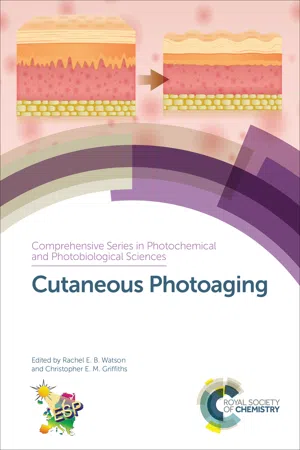
Cutaneous Photoaging
- 395 pages
- English
- ePUB (mobile friendly)
- Available on iOS & Android
Cutaneous Photoaging
About this book
Photoaging results from chronic exposure to UV radiation and is an increasingly common clinical feature, with an aging population the clinical burden is likely to increase despite advances in our understanding of the pathology and development of improved treatments. This book will present and review the latest progress from the forefront of translational research in cutaneous photoaging. The core chapters focus on the current understanding of the biochemical mechanisms of photoageing and lead on to aspects of photoprotection and photomedicine to provide a complete picture of the current field and a context for the importance of the basic mechanistic understanding. With a global team of authors Cutaneous Photoaging provides an international perspective on the causes, consequences, pathophysiology and treatment of photoaging, ideal for dermatologists, students and professionals in photoscience.
Frequently asked questions
- Essential is ideal for learners and professionals who enjoy exploring a wide range of subjects. Access the Essential Library with 800,000+ trusted titles and best-sellers across business, personal growth, and the humanities. Includes unlimited reading time and Standard Read Aloud voice.
- Complete: Perfect for advanced learners and researchers needing full, unrestricted access. Unlock 1.4M+ books across hundreds of subjects, including academic and specialized titles. The Complete Plan also includes advanced features like Premium Read Aloud and Research Assistant.
Please note we cannot support devices running on iOS 13 and Android 7 or earlier. Learn more about using the app.
Information
*E-mail: [email protected]
This chapter discusses the prevalence of photoaging in white Northern Europeans, as well as describing the two main facial photoaging phenotypes, termed ‘hypertrophic’ photoaging (HP) and ‘atrophic’ photoaging (AP). HP individuals have deep, coarse wrinkles, whereas those with AP have relatively smooth, unwrinkled skin with pronounced telangiectasia. Both phenotypes have distinct histological characteristics. AP has a significantly thicker epidermis than HP. Further stratification by gender demonstrates that the AP epidermal thickness is increased significantly in males as compared to females. HP photoaged skin exhibits severe solar elastosis, characterized by extensive deposition of amorphous, abnormally thickened, curled and fragmented elastic material in the dermis. In AP photoaged skin, there are gender differences in elastic fibre deposition; solar elastosis is apparent in females but not in males. Loss of papillary dermal fibrillin-rich microfibrils is a distinctive feature of photoaging occurring in both HP subjects and in AP females. It is important for clinicians to recognize that these two phenotypes exist because individuals with the AP phenotype have an increased propensity for developing keratinocyte cancers. Lastly, tools for measuring and objectively assessing response of photoaged skin to treatment exist and should be used for these purposes.
1.1 The Scope of the Photoaging Problem
1.2 Introduction
| Features | Intrinsic aging | Extrinsic aging |
| Clinical appearance | ||
| Smooth, unblemished | Nodular, leathery, blotchy | |
| Fine wrinkling | Deep wrinkling | |
| Epidermis | ||
| Thickness | Thinner than normal | Hyperplasia in early stages, and atrophy in end stages |
| Proliferative rate | Lower than normal | Higher than normal |
| Basal keratinocytes | Modest cellular irregularity | Marked heterogeneity |
| Keratinization | Unchanged | Numerous dyskeratoses |
| Dermal–epidermal junction | Loss of rete pegs, flat, modest reduplication of lamina densa | Loss of rete pegs, flat extensive reduplication of lamina densa |
| Dermis | ||
| Grenz zone | Absent | Prominent |
| Elastin | Elastogenesis followed by elastolysis | Marked elastogenesis followed by massive degeneration – dense accumulations in dystrophic elastic fibres |
| Collagen | Modest change in bundle size and organization | Modest change in bundle size |
| Microvasculature | Normal architecture | Abnormal architecture |
| Inflammatory cells | No evidence of inflammation | Perivenular, histiolymphocytic infiltrate |
1.3 Intrinsic Aging
1.3.1 Histological Changes o...
Table of contents
- Cover
- Half Title
- series editor
- Title
- Copyright
- Preface
- Contents
- Chapter 1 Photoaging in Caucasians 1
- Chapter 2 Photodamage in Skin of Color 31
- Chapter 3 Photoaging in Far East Populations 59
- Chapter 4 The Skin Aging Exposome 83
- Chapter 5 Oxidative Stress, Metabolism and Photoaging – The Role of Mitochondria 105
- Chapter 6 Pigmentation and Photoaging 145
- Chapter 7 Epidermal Stem Cells and Dermal–Epidermal Junction 167
- Chapter 8 Collagen Damage Induced by Chronic Exposure to Sunlight 195
- Chapter 9 Solar Elastosis and the Dermal Elastic Fibre Network 213
- Chapter 10 Do Proteoglycans Mediate Chronic Photoaging? 231
- Chapter 11 Photoprotection in the Prevention of Photodamage and Cutaneous Cancer 275
- Chapter 12 Cosmeceuticals 315
- Chapter 13 Topical Retinoids for the Treatment of Photoaged Skin 341